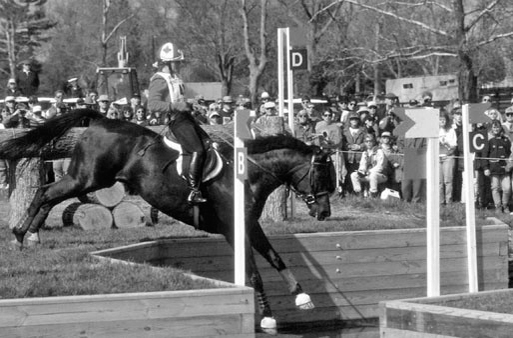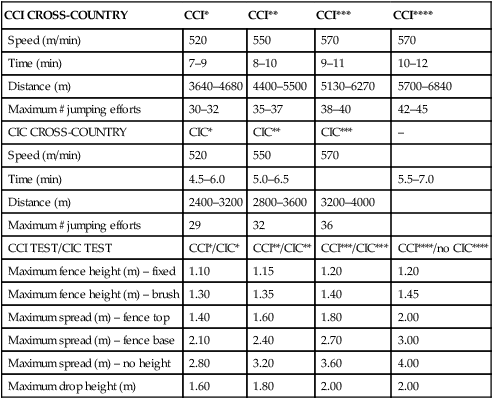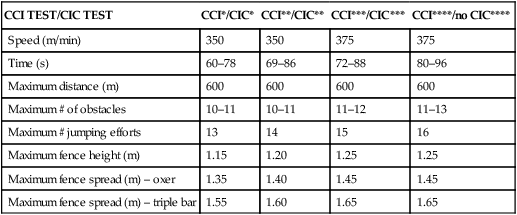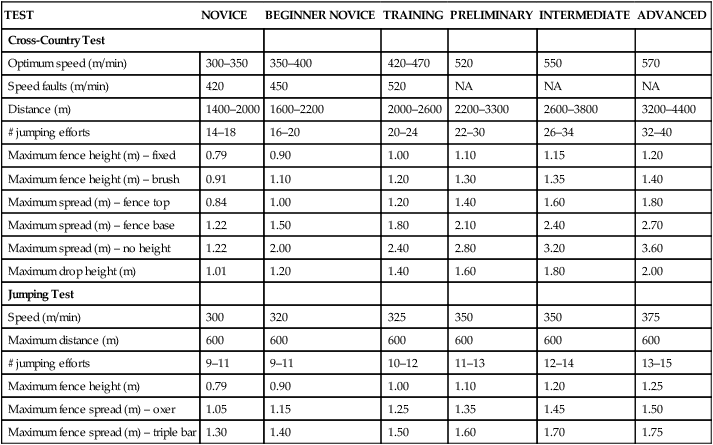Event horses are required to perform three sports in one: dressage, cross-country, and show jumping.1 Events take place over one to three competition days. Complete three-day events (3DE) involve three tests on consecutive days: the Dressage Test on the first day, the Cross-Country Test (previously termed the Speed-and-Endurance Test) on the second day (Fig. 50.1), and the Jumping Test on the third day. The Dressage Test is intended to test obedience, balance, and suppleness in horses fit enough to gallop and jump Cross-Country the following day. Cross-Country is competed by galloping and jumping over 30–45 immovable obstacles with heights and spreads requiring speed, endurance, jumping scope, and courage on the part of both the horse and the rider (Fig. 50.1).1 In the newer short format, the warm-up phases for Cross-Country are no longer a part of the formal judged competition. The reasoning behind the third day’s test, show jumping, is to determine which horses are best able to compete effectively after the rigorous second day of the Cross-Country Test. Internationally the sport is known as the Concours Complet d’Equitation Internationale (CCI, translated as ‘complete equestrian competition’).1,2 International 3DE are ranked by the FEI as one (CCI*) through four-star (CCI****).1 Annual CCI**** include Badminton and Burghley in the United Kingdom and Rolex Kentucky in the USA. The abbreviation CCIO designates an Official (Officiel) CCI to which national federations are invited to send selected representative teams and individuals, such as for the Olympic Summer Games or World Equestrian Games.1 One- and most two-day events are usually termed Horse Trials and involve a Dressage Test followed by an abbreviated form of the Cross-Country Test (Phase D only) and the Jumping Test, the latter two tests in no specified order.1 The FEI recognizes international horse trials with the designation CIC (Concours Internationale de un jour, one- through three-star levels, Tables 50.1 and 50.2).1 American events and horse trials are sanctioned by the United States Equestrian Federation (USEF) and are ranked in increasing difficulty as Beginner Novice, Novice, Training, Preliminary (comparable to CCI*), Intermediate (CCI**), and Advanced (CCI***) (Table 50.3).3 Combined Tests usually include only two of the three disciplines on a single day.3 Table 50.1 Speeds, times, distances, number (#) of jumping efforts, and maximum fence heights, spreads, and drop heights required by FEI for sanctioned CCI and CIC Cross-Country Tests4 Table 50.2 Speeds, times, distances, number (#) of obstacles, number of jumping efforts, and maximum fence heights, spreads, and drop heights required by FEI for sanctioned CCI and CIC Jumping Tests4 Table 50.3 Speeds, times, distances, and maximum fence heights, spreads, and number (#) of jumping efforts for United States Equestrian Federation events and horse trials3 Eventing began as a cavalry competition in northern Europe and made its first appearance as an Olympic sport in Stockholm in 1912. Over the years the sport has evolved through various iterations. In the older (now mainly abandoned) long format or ‘classic’ event, Cross-Country Day involved four phases.4 Phase A was a trotting warm-up for Phase B, the Steeplechase, in which the horse galloped over brush fences at much faster paces (Table 50.1). Phase C was designed as a cool-down phase after Steeplechase. Phases A and C were known collectively as Roads and Tracks. After Phase C there was a mandatory veterinary inspection for 10–15 minutes (Phase X) to determine that the horse was sound and fit to continue. Phase D was the Cross-Country Test itself over numerous immovable obstacles with heights and spreads increasing with increasing levels of difficulty (Fig. 50.1).4 Prior to the 1960s, there was also a fifth phase on Cross-Country Day, Phase E, involving another warm-down Roads and Tracks phase after the Cross-Country phase. An additional rest stop (C Halt) became mandatory in long-format CCI*** and CCI**** in 1999. In 2002, the recommended distances for all phases were shortened and the speed required for Phase C was decreased to allow more walking for increased recovery from Phase B (Table 50.1).4 These changes were made in response to a spate of recent fatal rider injuries and were based in part on the results of thermoregulatory research on Phases B and C performed prior to the 1996 Atlanta Olympic Summer Games.5–23 That research demonstrated that shortening Phase B,7–9 inserting two additional rest stops (C Halt) on Phase C,9 and walking some (not all trotting) on Phase C9 increased recovery under hot and humid conditions. Because a subcommittee of the International Olympic Committee in 2002 recommended abandoning eventing as an Olympic discipline, the short format was adopted for safety and financial concerns beginning with the Athens Olympics in 2004. The short format has now become the predominant form of 3DE throughout the world. The Fédération Equestre Internationale (FEI) is the international governing body for nine equestrian sports, including dressage, show jumping, eventing, driving, vaulting, endurance, reining, para-dressage, and para-driving.2 Each nation has its own national equestrian federation. Each national federation is a member of the FEI and governs competition at the national or regional level within that nation, whereas the FEI governs international competition. The national equestrian federation of the United States is the United States Equestrian Federation, formerly known for decades as the American Horse Shows Association (AHSA) and more recently known briefly as USA Equestrian. The International Olympic Committee (IOC) oversees Olympic competition. The FEI reports to the IOC for Olympic equestrian sports, including dressage, show jumping and eventing. When the long format was the only format in 3DE, upper-level horses were primarily Thoroughbreds or Thoroughbred crosses. The Thoroughbred influence was necessary to have the inherent fitness and stamina required at the upper levels of long-format eventing. According to the World Breeding Federation for Sport Horses, in 1999–2000 all 10 of the Top 10 Sires of internationally ranked event horses were Thoroughbreds.24 With less stamina required for the shorter distances in the newer short format, Warmbloods have now come to dominate the upper levels of eventing, particularly as they are better suited to achieve superior dressage scores. In 2011, the first 10 of the Top 100 Sires of event horses were Warmblood stallions, with 5 of the top 10 being Irish Sport Horses.25 The 2011 FEI Top 10 Stud Book rankings for event horses were Selle Francais, Hanoverian, Irish Sport Horse, Holsteiner, Dutch Warmblood, Swedish Warmblood, Trakehner, British Sport Horse, Pferdezuchtverband Baden-Wuerttemberg, and Pferdezuchtverband Sachsen-Thüringen e.V.25 Five of the Top 10 Stud Books in eventing in 2011 were German Warmblood breeds.25 Why have German breeds become so predominant in eventing compared to the previous dominance of Thoroughbreds? The diminution of the length and stamina required in Cross Country, combined with the German breeds’ superior dressage movements, are the likely reasons. Gait and conformation analysis data on three-year-old dressage horses (n = 142) have shown German Warmbloods (Hanoverians [n = 31], Westphalians [n = 16], and Oldenburgers [n = 6]) to be biomechanically superior to both Selle Francais (n = 61) and purebred Spanish horses (n = 28) for use in competitive FEI dressage.26 The superior stature and conformation of the German horses results in a longer stride length and decreased stride frequency. ‘The German horses had gait characteristics more adapted to dressage competition,’ the authors concluded.26 Three-day event horses may compete in CIC* or CIC** at five years old.1 They must be at least six years old to compete in CIC***, CCI*, or CCI**.1 Event horses must be at least seven years old to compete in CCI*** and CCI****.1 They must be at least eight years old to compete in a Championship (‘an official team competition…open to athletes from an unlimited number of nations’) CCI****.1 Due to the collection, impulsion, bending, circling, and other movements required in dressage, common complaints in event horses include sore backs or hocks. Riders often complain of a horse’s unwillingness to bend, perhaps worse in one direction than the other. Jumping and galloping Cross-Country (Fig. 50.1) also contribute to injuries sustained by event horses, as do the rigorous training regimens required to achieve sufficient fitness to compete at the upper levels. Bowed tendons and suspensory desmitis are common supporting leg lamenesses. Traumatic injuries are not uncommon during Cross-Country. Many practitioners also have contact with these horses only at competitions, as treating veterinarians (the conventional ‘horse show veterinarian’), team veterinarians, drug testers, or official veterinarians. Treating and team veterinarians are also health care providers, but in the crucible of competition. Treating veterinarians often have contact with many of the same owners, riders, and horses over the course of a horse show circuit, and develop a valid long-term doctor–client–patient relationship. Team veterinarians function as treating veterinarians but for only one team, thus allowing more focused and intensive care for a more limited number of horses. The most difficult part of the team veterinarian’s job is remembering the FEI Code of Conduct for the Welfare of the Horse,27 which states that ‘all those involved in international equestrian sport…acknowledge and accept that at all times the welfare of the horse must be paramount and must never be subordinated to competitive or commercial influences.’27
Veterinary aspects of training event horses
Definitions and background

CCI CROSS-COUNTRY
CCI*
CCI**
CCI***
CCI****
Speed (m/min)
520
550
570
570
Time (min)
7–9
8–10
9–11
10–12
Distance (m)
3640–4680
4400–5500
5130–6270
5700–6840
Maximum # jumping efforts
30–32
35–37
38–40
42–45
CIC CROSS-COUNTRY
CIC*
CIC**
CIC***
–
Speed (m/min)
520
550
570
Time (min)
4.5–6.0
5.0–6.5
5.5–7.0
Distance (m)
2400–3200
2800–3600
3200–4000
Maximum # jumping efforts
29
32
36
CCI TEST/CIC TEST
CCI*/CIC*
CCI**/CIC**
CCI***/CIC***
CCI****/no CIC****
Maximum fence height (m) – fixed
1.10
1.15
1.20
1.20
Maximum fence height (m) – brush
1.30
1.35
1.40
1.45
Maximum spread (m) – fence top
1.40
1.60
1.80
2.00
Maximum spread (m) – fence base
2.10
2.40
2.70
3.00
Maximum spread (m) – no height
2.80
3.20
3.60
4.00
Maximum drop height (m)
1.60
1.80
2.00
2.00

CCI TEST/CIC TEST
CCI*/CIC*
CCI**/CIC**
CCI***/CIC***
CCI****/no CIC****
Speed (m/min)
350
350
375
375
Time (s)
60–78
69–86
72–88
80–96
Maximum distance (m)
600
600
600
600
Maximum # of obstacles
10–11
10–11
11–12
11–13
Maximum # jumping efforts
13
14
15
16
Maximum fence height (m)
1.15
1.20
1.25
1.25
Maximum fence spread (m) – oxer
1.35
1.40
1.45
1.45
Maximum fence spread (m) – triple bar
1.55
1.60
1.65
1.65

TEST
NOVICE
BEGINNER NOVICE
TRAINING
PRELIMINARY
INTERMEDIATE
ADVANCED
Cross-Country Test
Optimum speed (m/min)
300–350
350–400
420–470
520
550
570
Speed faults (m/min)
420
450
520
NA
NA
NA
Distance (m)
1400–2000
1600–2200
2000–2600
2200–3300
2600–3800
3200–4400
# jumping efforts
14–18
16–20
20–24
22–30
26–34
32–40
Maximum fence height (m) – fixed
0.79
0.90
1.00
1.10
1.15
1.20
Maximum fence height (m) – brush
0.91
1.10
1.20
1.30
1.35
1.40
Maximum spread (m) – fence top
0.84
1.00
1.20
1.40
1.60
1.80
Maximum spread (m) – fence base
1.22
1.50
1.80
2.10
2.40
2.70
Maximum spread (m) – no height
1.22
2.00
2.40
2.80
3.20
3.60
Maximum drop height (m)
1.01
1.20
1.40
1.60
1.80
2.00
Jumping Test
Speed (m/min)
300
320
325
350
350
375
Maximum distance (m)
600
600
600
600
600
600
# jumping efforts
9–11
9–11
10–12
11–13
12–14
13–15
Maximum fence height (m)
0.79
0.90
1.00
1.10
1.20
1.25
Maximum fence spread (m) – oxer
1.05
1.15
1.25
1.35
1.45
1.50
Maximum fence spread (m) – triple bar
1.30
1.40
1.50
1.60
1.70
1.75

Equestrian sports governance
Demographics
Veterinary services
![]()
Stay updated, free articles. Join our Telegram channel

Full access? Get Clinical Tree


Veterian Key
Fastest Veterinary Medicine Insight Engine
